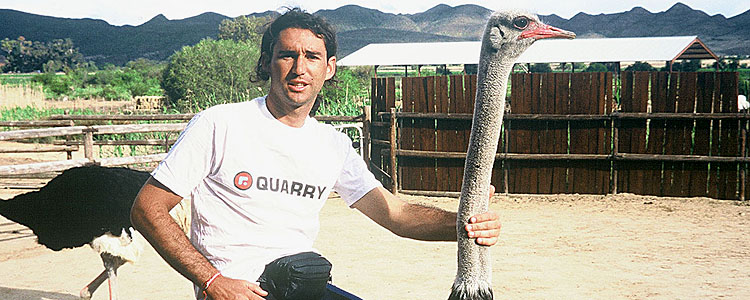I never imagined that my pedaling might alternate with the ride of an ostrich. When Innocent, asked me if I dared, I hadn’t no doubt. But to ride an ostrich is not as easy as to ride a horse.
Land of ostriches, km 12,470
I never imagined that my pedaling might alternate with the ride of an ostrich.
When Innocent, the guide speaking Spanish mix with English, asked me if I dared, I hadn’t no doubt.
According to Innocent, the male ostrich can carry persons up to 75 kg of weight. Luckily for me, this little bird didn’t perceive that I was 2 kg above that limit. And besides, I was already there, the animal was looking at me and
seemed that he was waiting for me, I won’t stop to live this experience for anything off the world.

To ride an ostrich is not as easy as to ride a horse. Its legs are long, for what is necessary to be climbed from a fence. The guide had explained of the convenience of covering its head, in order to prevent that it disassembles me.
Once firmly positioned on the animal, grabbing the big wings as if they were the reins, Innocent took the bird’s hood off and a race without a certain direction began.
Fearing falling off on my butt, I tried to hang on to the feathers as strongly as I could, while the manager of the farm yelled at me: careful with this bird that is running a lot!
At a certain point I noticed that I was hanging nearer the ground than the ostrich’s neck, and then I let go off its wings and opened my legs as quickly as I could,enabling me to fall standing just behind it, that which scared me because I thought that perhaps it wanted to make up for and could kick me like a horse. But ostrich doesn’t kick. It picks.
Once I was down on earth again, the animal turned around, looked at me, looked very closely… and went walking away calmly seeking its next rider. Without doubt it was an experienced animal: it knew that it was better to be amiable and carry around tourists, than ending being tasted by them at the next restaurant in town.
Oudtshoorn
I have been in the route for several days. My rhythm is paused and very observing.
In some places, in the look of the people, the consequences of the apartheid -abolished 1994 when Nelson Mandela won elections- can still be perceived. Until this times the whites had been absolute owners of politic power in this country with majority of black people.

Oudtshoorn, capital of the ostrich and one of the most important destinies for alternative tourism. 350 farms have the monopoly over 70 % of the world market with a total of 750.000 ostriches, at a ratio of 7 for each inhabitant of this city, which even being small is a big industrial potency.
The history of the ostrich reaches back to the middle of XIX century, and being the golden years the ones before the First World War, when Oudtshoorn held over a million animals. Europe was buying a big part of the production of feathers to be used for embellishment of hats, which were very trendy at the upper circles of these days.
Today Oudtshoorn has recovered its strong position as an exporting industry on the ostrich market, even if this time it is not the feathers to be sold but the meat for countries likes England, France, Portugal and Germany amongst others.
Only Brazil stands out for buying the feathers, using them for the dresses of the dancers of typical Carnival “comparsas“.
The numbers surprised me: from Monday to Thursday, using electroshock, they sacrifice 750 ostriches, but only on Friday they sacrifice 500 ostriches. And even though this animal can live 60 years, at 14 months it ends on a grill.
Its red meat can easily be mistaken for cow’s beef, and even I did not taste it, I heard it has a most delightful taste.
The egg sized is about a rugby ball, and with it an omelet for 15 persons can be prepared.
But if you want a hard-boiled egg, you’ll have to wait one hour and a half to be done. Beware the cholesterol, it has a lot. Just one ostrich’s egg is similar to 24 chicken eggs.
They say that the ostrich doesn’t know how to count, and loses account of the number of eggs that it lays, being normally that it lays between 15 and 18 eggs between the months of July and December. If you take them away it sometimes lays up to 60 eggs, and keeping the female the last 15. After that it’s necessary to wait 42 days to let them be born.
After 3 days at the Safari Farm, where I learned a lot, I returned to the route to be always welcomed by the natives.



